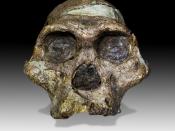Summary Paper
Sunset on the Savanna
"Why do we walk? For decades anthropologists said that we became bipedal
to survive on the African savanna. But a slew of new fossils have destroyed that
appealing notion and left researchers groping for a new paradigm."
Sunset on the Savanna, James Shreeve, Discover, July 1996, pp.116-125.
It has generally been thought that it was the shift from life in the forest to life in an open habitat that set the ape apart by forcing it to walk on two legs. More simply stated, we learned to walk by moving from the trees to living on the grasslands. Bipedalism offers hominids the ability to see over tall savanna grasses, to more easily escape predators, and gives the ability to walk more efficiently over long distances. James Shreeve, however, examines this theory, and using fossil evidence, casts serious doubts as to its validity. The whole idea, in fact, will be put to rest once and for all if one particular fossil discovery is shown to have been bipedal.
The savanna hypothesis was proposed over 100 years ago. Shreeve tells us that Charles Darwin believed that our early ancestors "...moved from some warm, forest clad land owing to a change in its manner of procuring subsistence, or to a change in the surrounding conditions." Darwin also believed that this happened in Africa, where the great apes live to this day. By the turn of the century however, the majority of anthropologists thought that this move had occurred in Asia. With the discovery of Australopithecus africanus in 1925 by Raymond Dart, near the town of Taung in South Africa, Africa was shown to be the home continent of our ancestors. Because the locations of these early fossils were arid grasslands, it seemed to support the savanna theory...


